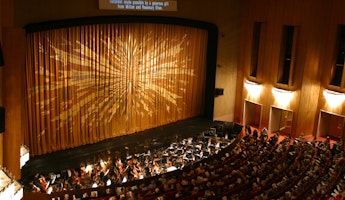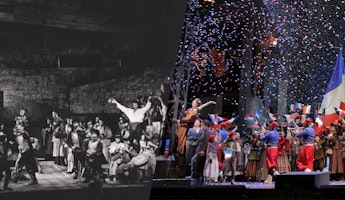Blog
March 10, 2022
The Creation of a Classic
John Neumeier in conversation with Jörn Rieckhoff
THESE PERFORMANCES ARE TAKING PLACE MORE THAN FOUR DECADES SINCE YOU CREATED ST. MATTHEW PASSION FOR THE HAMBURG BALLET. WHAT IS IT LIKE TO REVISIT A PIECE SO MANY YEARS LATER?
When I created St. Matthew Passion, I worked on it almost every day from the first rehearsal day of the season in August 1980 to the premiere of the complete version on June 25, 1981. With its approximately three and a half hours running time, it is obviously difficult to reconstruct and to rehearse in a repertoire situation.
After the premiere, we performed it almost every season and the roles were passed down from one generation of dancers to the next. For the scenes of reaction and improvisation, the experienced dancers coached their younger colleagues. However, when it was revived in 2016 after a longer performance pause, almost all the dancers involved had to relearn the piece. Knowing it would be a long process, I decided to start from scratch, with young dancers who would continue to pass this work on in the future.
WHEN YOU BEGAN YOUR CREATIVE PROCESS, IT WASN'T COMMON TO ASSOCIATE BACH'S SACRED MUSIC WITH DANCE. HOW DID YOU COME UP WITH THE IDEA?
It began with the incredible experience of hearing Bach's music. I first heard the entire St. Matthew Passion on April 4, 1965, in Stuttgart’s Stiftskirche. I was then a soloist at the Stuttgart Ballet and had only choreographed a few pieces at that time. Nonetheless, I felt immediately, intuitively, that I must one day create a ballet on this music.
Much later, in Hamburg, I tried several times to realize this enormous project—but met with no encouragement. Only the intendant of the Hamburg State Opera, August Everding, showed interest. I even traveled to New York to ask James Levine to conduct; he had to decline. My determination to create the work persisted. Christoph von Dohnányi, a later intendant of the Hamburg State Opera, considered it “experimental” and a project that would have little chance of success or a lasting place in the repertoire. Ultimately, an encounter with Günter Jena, the music director at St. Michael’s Church, became the deciding factor. He had invited me to choreograph a piece in the church, set to organ music. Visiting St. Michael’s, he played several works for me which did not excite me. I had something else in mind…
On the balcony of St. Michael's Church, I asked him if he could envision a ballet based on the St. Matthew Passion. He replied: "That would be the dream of my life." Only then, because Jena believed in the idea and became a partner, did the entire project become possible.
IN THE YEARS THAT FOLLOWED, YOU DEVELOPED THE ST. MATTHEW PASSION IN VARIOUS VERSIONS, ORIGINALLY WITH THE TITLE SKETCHES FOR THE ST. MATTHEW PASSION. WHY IS THAT, AND HOW DID YOU, AS A CHOREOGRAPHER, TACKLE THE BALLET?
I decided to realize sections of the project first in the church—where, historically, it originated—before transferring it to the opera house. The Sketches were not intended as a possible performance version, but as a kind of “try out” experiment using a carefully structured musical outline of the Passion involving all its various forms of music. The Sketches should answer my choreographic questions: How can I choreograph a recitative? What would the transition from a chorale to an aria look like? During an aria, what would the non-participating dancers do? I really felt I needed to try these things out with my dancers.
The basic question at the beginning of the work was: How to choreograph music for which you feel such great respect? After looking deeply into the musical structure of each movement and studying the text, my intention was not to illustrate the biblical narrative, but to choregraph my personal reactions to the piece. The Passion is an oratorio. Unlike an opera, the audience here is expressly called upon to participate and to identify with the biblical events. In the original liturgical context, this was accomplished by the congregational singing of the chorales. In Bach's St. Matthew Passion, the narrative is described in the recitatives very succinctly. Far more important are the choruses and arias which express the feelings of the congregation or audience in regard to what is happening. My dances therefore give living shape to my personal reflections on the basic situations and emotions expressed in the Bible text.
THERE IS STILL THE CHALLENGE OF HOW TO DEPICT THE BIBLICAL EVENTS. ARE THERE CERTAIN DANCERS WHO PORTRAY THE VARIOUS ROLES, WITH OTHERS ASSIGNED MORE TO THE LEVEL OF REFLECTION?
One of my main ideas in St. Matthew Passion is to avoid a clear separation between biblical characters and “witnesses.” At the beginning, all the dancers enter the stage as themselves—as private individuals, so to speak. They sit and listen to the music intensely. The music inspires them to move. In the choreography, the images that emerge are the physical results of their emotional reaction to this music. When the biblical passion story is told, some dancers may take on the gospel characters, not, however, wearing specific costumes, but simply by putting themselves inside these characters. Asking themselves, for example: What would I feel like being Judas?
All other dancers remain “witnesses.” No matter what nation or culture the dancers come from or what religion they may practice, they must listen to the text, then decide for themselves how to respond—positively or negatively or not at all. But all must remain present at all times! Whatever their reaction is, they have to be there on the stage, experiencing what is happening in front of them. In many of these situations, I give the dancers freedom to improvise, encouraging them to respond as individually and authentically as possible. When Peter realizes that he has denied Jesus three times, for example, that dancer approaches the entire group of fellow dancers and must endure their gaze—their judgement and possible rejection. When I was creating the Peter section, I told the group to imagine that this person has done something incredibly bad: he is a child molester, or he has murdered a friend—and now he regrets it. How would you react to your dancer-colleague? Would you turn away in disgust? Would you feel sympathy or even comfort him?
The freedom of the individual dancer in a moment like that makes St. Matthew Passion a constantly “living,” relevant work of art, because all of the dancers must bring themselves and their own life experiences onto the stage during these hours of shared experience. The feelings and actions that we witness are based on actions and situations we all recognize, have experienced in some degree and can relate to personally.
Jörn Rieckhoff is the Director of Communications and Dramaturgy at the Hamburg Ballet.








/03-cosi/_dsc0996_pr.jpg?format=auto&fit=crop&w=345&h=200&auto=format)















